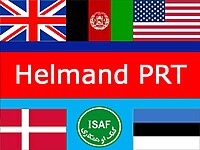Provincial Reconstruction Team Helmand
| Provincial Reconstruction Team Helmand | |
|---|---|

Insignia of PRT Helmand
|
|
| Role | Reconstruction/Area Security |
The Helmand Provincial Reconstruction Team (PRT) was established in September 2004. It was led by the US until 1 May 2006, when this responsibility was handed to the UK. HPRT ceased operations in LashKar Gah on 27 December 2013. With a core team of over 100 civilian and military staff it was once one of the largest PRTs in Afghanistan.
The PRT worked to deliver a provincial stabilisation and development plan that had been agreed between the Government of Afghanistan and international partners. The plan coordinated the efforts of 9 themes, or strands: Governance and Politics; Rule of Law; Counter-Narcotics; Population Engagement; Health; Education; Agriculture; Infrastructure and Private Sector Development. To deliver this Helmand PRT worked with the Government of Afghanistan, ISAF, and the ANSF.
The PRT has achieved its aim of building a strong platform for future governance and development in Helmand. HPRT will close before the end of 2014 in line with the timetable for PRT closures throughout Afghanistan set by President Karzai. HPRT’s focus has moved from stabilisation to transition. By the time of closure its work streams will be Afghan led. This is being achieved through the delivery of a single Helmand Plan that has been agreed between the Government of Afghanistan and its international partners.
The Helmand PRT was headquartered in the province's capital, Lashkar Gah. It operated district field offices on military bases in Gereshk, Garmsir, Sangin, Nad-e Ali, Now Zad, Marjah, Khan-e shin and Musa Qalah. These offices are now closed.
The Helmand PRT was part of the International Security Assistance Force in Afghanistan and was located within Regional Command Southwest. HPRT was funded by the UK, USA, Danish and Estonian Governments. UK, US and Danish District Stabilisation Teams were located in 11 of Helmand’s 14 Districts. A Stabilisation Team typically comprised: civilian stabilisation advisers (STABADs); civilian specialists (e.g. in agriculture); a political adviser; and working with a UK Military Stabilisation Support Team (MSST), a US Civil Affairs Team or a Danish CIMIC (Civil Military Cooperation) Support Team. The teams brought together people with a range of backgrounds including development, politics, engineering and project management. Afghan members of the team played a vital role, bringing local knowledge and relationships. The Stabilisation Teams worked alongside the District Regimental Battle Group or Battalion Headquarters to coordinate civil and military activity.
The PRT combined the UK's Department for International Development, USAID and the Danish Governments development agency (DANIDA) to provide £6m support to this initiative.
...
Wikipedia
